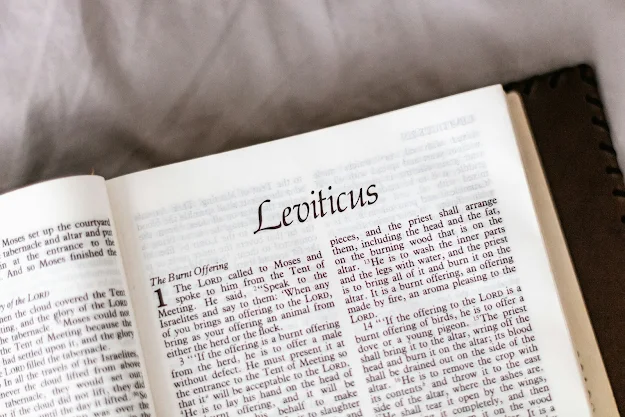Introduction to Leviticus 8
Leviticus 8 describes the ordination of Aaron and his sons as priests, following the instructions given in Exodus 28–29 and Leviticus 6–7. This chapter marks the beginning of the priesthood in Israel and emphasizes purity, obedience, and divine authority.
Detailed Breakdown of Leviticus 8
Leviticus 8 can be divided into several sections:
-
The Assembly and Preparation (Verses 1–4)
-
The Washing and Clothing of the Priests (Verses 5–9)
-
Anointing of the Tabernacle and Priests (Verses 10–13)
-
The Sin Offering (Verses 14–17)
-
The Burnt Offering (Verses 18–21)
-
The Consecration Offering (Verses 22–30)
-
Instructions for the Priests (Verses 31–36)
1. The Assembly and Preparation (Verses 1–4)
"And the Lord spake unto Moses, saying, Take Aaron and his sons with him, and the garments, and the anointing oil, and a bullock for the sin offering, and two rams, and a basket of unleavened bread; and gather thou all the congregation together unto the door of the tabernacle of the congregation." (Lev. 8:1–3)
-
God commands Moses to ordain Aaron and his sons.
-
Specific items are required:
-
Garments for priestly service (Exodus 28).
-
Anointing oil for sanctification.
-
Sacrificial animals: A bull for a sin offering, two rams, and unleavened bread.
-
-
Moses gathers the Israelites at the Tabernacle entrance, emphasizing public recognition.
2. The Washing and Clothing of the Priests (Verses 5–9)
"And Moses brought Aaron and his sons, and washed them with water." (Lev. 8:6)
-
Purification Ritual: Moses washes Aaron and his sons, symbolizing spiritual cleansing.
-
Garments (Exodus 28):
-
Tunic (linen robe).
-
Girdle (belt).
-
Robe of the Ephod (blue).
-
Ephod (priestly apron with gold, blue, purple, and scarlet).
-
Breastplate (holds Urim and Thummim, used to seek God’s will).
-
Mitre (turban) with the gold plate inscribed "Holiness to the Lord."
-
3. Anointing of the Tabernacle and Priests (Verses 10–13)
"And Moses took the anointing oil, and anointed the tabernacle and all that was therein, and sanctified them." (Lev. 8:10)
-
Moses anoints:
-
The Tabernacle and all sacred objects.
-
Aaron, pouring oil on his head (a sign of divine consecration).
-
Aaron's sons are also anointed.
-
Significance:
-
Anointing symbolizes the Holy Spirit and divine authority.
-
The priesthood is not self-appointed but chosen by God.
4. The Sin Offering (Verses 14–17)
"And he brought the bullock for the sin offering: and Aaron and his sons laid their hands upon the head of the bullock for the sin offering." (Lev. 8:14)
-
Laying hands on the bull signifies the transfer of sin.
-
Moses slaughters the bull, applying blood to the altar.
-
The carcass is burned outside the camp (symbolizing the removal of sin).
Significance:
-
The sin offering atones for impurity.
-
The priests must first be cleansed before serving others.
5. The Burnt Offering (Verses 18–21)
"And he brought the ram for the burnt offering: and Aaron and his sons laid their hands upon the head of the ram." (Lev. 8:18)
-
The ram is completely burned on the altar.
-
Symbolism:
-
Total devotion to God.
-
Priests must be fully consecrated.
-
6. The Consecration Offering (Verses 22–30)
"And he brought the other ram, the ram of consecration: and Aaron and his sons laid their hands upon the head of the ram." (Lev. 8:22)
-
Blood is applied:
-
Right ear → Obedience to God.
-
Right thumb → Holy service.
-
Right big toe → Holy walk before God.
-
-
Moses takes the blood, anointing oil, and garments to consecrate the priests.
Significance:
-
The priests are set apart entirely for God’s service.
-
Holiness must affect hearing, actions, and walk.
7. Instructions for the Priests (Verses 31–36)
"And ye shall not go out of the door of the tabernacle of the congregation in seven days, until the days of your consecration be at an end." (Lev. 8:33)
-
Priests must remain in the Tabernacle for seven days.
-
They must eat the sacrificial meal inside.
-
Obedience is crucial: Failure to follow God’s instructions results in severe consequences (as seen later in Leviticus 10 with Nadab and Abihu).
Theological Themes in Leviticus 8
-
Obedience to God’s Commands
-
Every step follows God’s instructions exactly.
-
True worship requires faithful obedience.
-
-
Consecration and Holiness
-
Priests represent intercessors between God and Israel.
-
Holiness is not an option but a requirement.
-
-
Sacrifice and Atonement
-
Blood sacrifices point to Jesus Christ, our High Priest (Hebrews 9:11–14).
-
Sin requires a substitute.
-
-
Public Witness of God’s Work
-
The ordination is witnessed by the congregation.
-
True faith is lived openly, not in secret.
-
-
Divine Anointing
-
The anointing oil symbolizes God’s Spirit.
-
True ministry is empowered by the Holy Spirit.
-
Connection to Jesus Christ
Leviticus 8 foreshadows Christ as our perfect High Priest:
-
Jesus was anointed by the Holy Spirit (Luke 3:21–22).
-
He was washed in baptism, symbolizing purity (Matthew 3:13–17).
-
His sacrifice was once for all (Hebrews 9:12–14).
-
His obedience fulfilled the law perfectly (Matthew 5:17).
Conclusion
Leviticus 8 is a foundational chapter for understanding priestly consecration, holiness, and atonement. It teaches that service to God requires purification, obedience, and divine empowerment. Ultimately, it points to Jesus Christ, the ultimate High Priest, who makes us a kingdom of priests (Revelation 1:6).





No comments:
Post a Comment